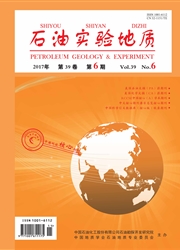

 中文摘要:
中文摘要:
对鄂尔多斯盆地大牛地气田上古生界太原组、山西组和下石盒子组储层砂岩成岩作用、孔渗结构及微裂隙分析及与产能关系进行了研究,认为该区压实作用是储层孔渗变差的主要原因,胶结作用使储层砂岩的孔渗进一步变差,溶蚀作用使储层孔渗得到一定的改善。胶结作用的类型与强度在不同地层存在差异:下石盒子组以较强的碳酸盐胶结与一定的硅质胶结为主,太二段以强硅质胶结与弱的碳酸盐胶结为主。孔渗分析显示盒3、盒2段较大渗透率相对占有优势,认为与微裂隙相关;盒3、盒2的产能高、压降慢的主要原因也可能与微裂隙较发育有关。
 英文摘要:
英文摘要:
Based on analysis of petrology, diagenesis, pore structure, microfracture and relationship with the gas yield of the Upper Palaeozonic reservoir sandstones in Daniudi Gas Field, Northern Ordos Basin, fine diagenetic difference exists on Upper Palaeozoic potential reservoir. The compaction is the main diagenesis resulting in pore and permeability lost, cementation greatly changes the pore structure and further reduces porosity and permeability although dissolution may improves the reservoir quality to some extent. The cementation type and strength exhibit difference with stronger quart and relatively less carbonates cementation in Carboniferous Taiyuan Formation (C1t), and with less quart and relatively stronger carbonates cementation in Lower Shihezhi Formation(P1x). Pore structure analysis shows that the Third and Second Member of Lower Shihezhi Formation (P1x^3 and P1x2) with larger permeability than P1x^1 and other reservoirs is re- lated with the microfractures contributing to higher production capacity in Px^3 and Px^2.
 同期刊论文项目
同期刊论文项目
 同项目期刊论文
同项目期刊论文
 Formation mechanism of carbonate cemented zones adjacent to the top overpressured surface in the cen
Formation mechanism of carbonate cemented zones adjacent to the top overpressured surface in the cen 期刊信息
期刊信息
